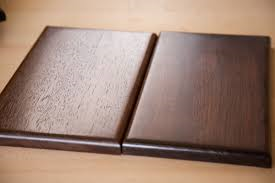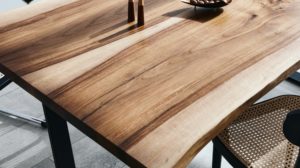Solid wood furniture is highly prized, and some people don't want to have furniture other than solid wood. Stains, waxes and oils can be used to embellish and protect it, but synthetic varnishes are also used, which are stronger but more demanding. If certain conditions are not respected, the finish can crack over time, often independently of the quality of the varnish. Let's take a look at the problems with varnish coatings on solid wood, what causes them and how they can be avoided or remedied.
Wrong or incomplete drying of the wood leads to varnish film defects
Sometimes the finished surface of furniture sometimes shows fine cracks along the wood grain. The first reaction is always "the lake is to blame". Sometimes - quite rarely - the lake may also play a part, but in most cases cause is solid wood that has not been thoroughly dried.
To be properly dried The solid wood must be allowed to stand in the kiln, respecting the specific drying time and cycle, until it reaches equilibrium at a moisture content of 8-12% for wood used indoors. This is for forced drying. In the case of natural drying, the lumber has to dry for at least 9 months in the stack, during which time the water drains out of the wood until it reaches equilibrium moisture content.
Forced drying (by raising the temperature in the kiln or keeping the wood directly in the sun) can cause cracking, but also differential moisture in the wood, higher on the inside and lower on the outside. Over time, the wood will try to balance its moisture, and in the process it will move. If these movements continue after finishing, the varnish will "feel" them and if it is not sufficiently elastic, fine cracks may appear along the grain throughout the varnished surface.
This is why exterior varnishes are very elastic, even if this is at the expense of hardness. Outdoors, where the wood should have moisture in the 14-18% range, the possibility of the wood being influenced by atmospheric moisture variation is much greater. The result is a movement of the wood which, in the absence of a resilient varnish, would lead to cracking in the wood coat.
Wrong sanding is the cause of many finishing defects
Finishing defects that originate in the correctness with which the wood is prepared before varnishing are lack of grip, differentiated absorption and stained appearance. All these are caused by the wood being sanded incorrectly before the finish is applied. Polishing should be done in increments, using increasingly finer sandpaper. The sanding paper should also be changed when it becomes loaded with wood dust or when the abrasive glued to the paper starts to fade. If the wood is not well sanded, the raised grain is not broken but pressed, forming so-called mirrors. In these areas, the wood does not absorb properly, resulting in stains or lack of grip.

Defects can also occur due to differential dye absorption in the splice areas (straight or toothed splices), where there are fiber ends that absorb more dye (even up to 100 times more). This makes the joint stand out, which is not accepted by everyone. Differential absorption can be avoided by using an insulator before dye application. A solution can also be to apply a very diluted primer and then apply the colorant.
Poor construction solutions can also have an effect on the varnish film
Sometimes the constructive solution for wooden doors is to fit a panel into a frame. The board does not have to be glued down precisely to allow the wood to vary dimensionally as the outside humidity decreases or increases. If the battens were glued to the frame, the system would become very stiff and movement would be much more noticeable, which can lead to cracks in the varnish film. But bear in mind that in very low humidity (as can happen in winter) the frame may shrink and the previously hidden portion may become visible. If it is not finished in the same way as the whole door, that portion will stand out. To avoid this the edges of the trim should be stained before it is put into the frame. This is a tip we add to the others about staining, varnishing and painting wooden doors.
The application technology must be in accordance with the wood used in order to avoid film defects
In the case of wood with large pores such as oak, mahon or nucSmall holes may appear in the film shortly after the furniture has been finished. This phenomenon is also called pore fall. Basically the pores become visible again. If the aim is a very good coating with complete closure of the pores, rediscovery is not acceptable. "Falling out" can be avoided by using an insulator or varnishes with hardener, such as polyurethane varnishes. The phenomenon of pore drop is especially common when finishing with nitrocellulose materials. Alternatively, the first coat of primer can be applied very thinly so that the primer "wets" the pores.

Furniture made from solid wood is not as easy to make as furniture made from engineered panels, and it is not enough to know how to mechanically process wood. You also need to have knowledge about wood species and their behavior over time, their main characteristics and "weak" points, drying, the influence of humidity and temperature and other such information. They are useful for producing quality furniture that will last for a long time.
If you have any questions or concerns you can leave them in the comments below, and if the topic may be helpful to others you can share it.




































Hello, I have a question, I have in my house a solid wood cabinet and a solid wood TV table, but they are of different colors because one is made of oak and the other I really don't know. I would like to sand and refinish that furniture and bring them both to the same color. But it should still be the colour of the wood. What steps should I take? (I was saying sanding, bath, then varnish. Is that ok?) it would help me enormously if you could give me some advice. Thank you in advance for your reply.
Good evening.
First of all you should know that if they are made of very different species of wood, for example oak and fir, it will be difficult to make them look alike, because the texture of the wood is different and has a different effect.
To remove the varnish layer you must sand with coarse abrasive sponges or 80 or 100 grit paper, then wipe the surface of the wood with a rag dipped in thinner. You can also try removing the varnish with paint stripper. You can find it at DIY stores like Dedeman, Hornbach, Practiker, BricoDepot, etc. I got some time ago Decanol made by Policolor, but there may be other brands. Apply the substance with a brush and let it work, then remove the soaked layer with a squeegee or scraper. Wipe off afterwards with thinner.
After you have cleaned well and the wood has dried after the thinner apply bait if you want to stain the wood. It will still be visible, but it will have a colour - walnut, cherry, oak - or whatever colour you want. After it dries you can apply clear varnish. Do not apply a thick coat. It is much better to apply 2 thinner coats. Thick coats crack over time. Apply the second coat after the first one has dried.
Good luck!
Hello. Excellent article, thank you.
I have two questions for you:
1. I want to make a bamboo edging that I can knock into the ground to support the difference in level between the flower border and the path. What varnish/type of varnish/other solution do you recommend I use to protect the wood from moisture and eventually rotting, but still maintain the natural colour of the wood?
2. I want to make a table in oak/European walnut for outdoor use, but I mention that it will be placed in a gazebo, protected from rain, but still exposed to temperature and humidity variations in the air and eventually probably to sunlight. And in this case I want to use a varnish/lacquer to keep the natural colour of the wood and highlight the fibres, but I want to get a smooth, dark pore look?
Good evening!
Thanks for your appreciation.
Bamboo wood is more special. Varnish adhesion is low due to the glossy surface and it absorbs hard as it is very dense. For outdoor use these are considered qualities. However, protection is needed for a better resistance.
1. Any product you use (oil, varnish, varnish), if it is totally transparent, does not provide UV protection. It must contain a small amount of pigment (5%). A very good protection against humidity is linseed oil. I would use an oil-based varnish, pine colour, for protection. It is semi-transparent, very bamboo-like in colour and is oil. To increase absorption sand the wood beforehand. You can also use water-based exterior varnish. In this case you have to make sure that the varnish is applied on all sides (including the edges) to prevent water absorption. Apply 2-3 coats.
2. And in this case I would still use oil. Oak, but especially walnut, looks great oiled. But oil does not make a film and does not work the pores. For such a finish you have to use exterior varnish. The ones with the highest resistance are the water-based ones. Apply 2-3 coats according to the instructions. For a smooth, silky sheen, use a 40-50 gloss varnish.
Good luck!
Thank you very much for your advice! Have a nice day!